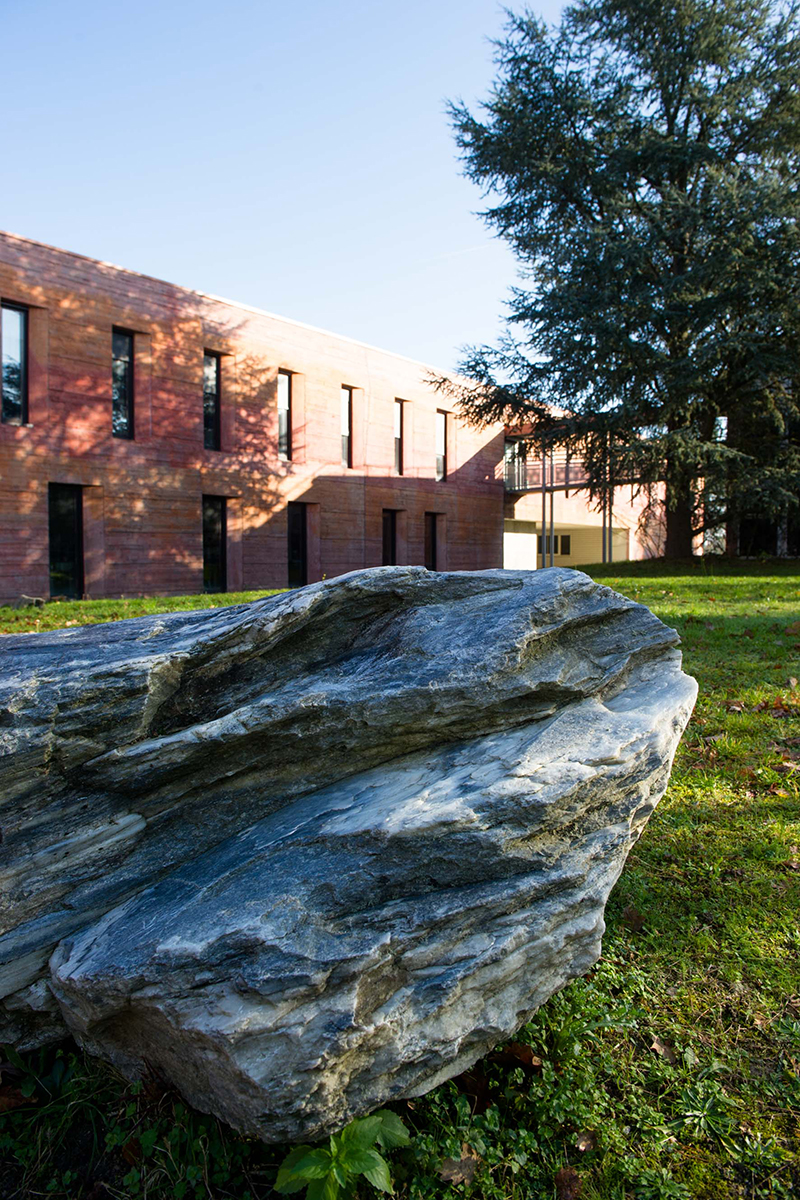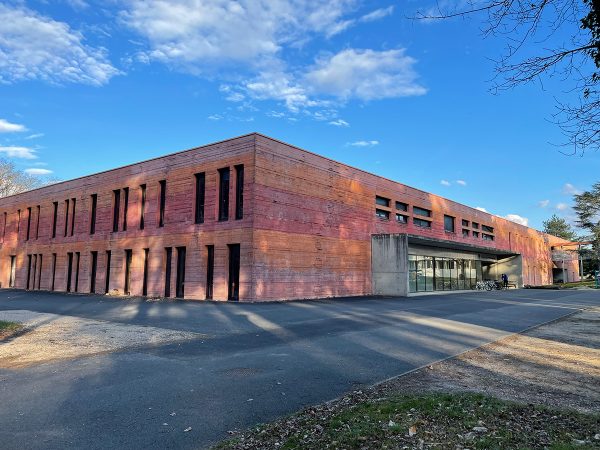ISTO, UMR 7327,
Univ Orléans, CNRS, BRGM, OSUC, F-45071 Orléans, France
Presentation of the Earth Sciences Institute of Orléans
- Home
- Presentation of the Earth Sciences Institute of Orléans
ISTO is a research institute covering a broad thematic spectrum with particularly wide scales of space (from mountain ranges to nanometric interfaces), time (minutes to millions of years) and particularly wide pressure-temperature ranges (-2 to +40 kbars; -40°C to 2000°C). The preferred field of study concern the biogeochemistry of the critical zone and the water-soil-plant-atmosphere continuum, reactive transport in saturated and unsaturated porous media, chemo-mechanical couplings, metallogeny and enrichment processes, thermodynamics and physics of silicate liquids and degassing processes, crustal rheology and localization of deformation on a geodynamic scale.
Three research groups structure our scientific fields: Magma & Deformation, Metallogeny and Geo-energy & Environment. These scientif fields are in the orbit of CNRS section 18 and 20. Metallogeny and Geo-energy & Environment are at the heart of the collaboration strategy with BRGM and are strongly linked to the scientific priorities of the region Centre-Val de Loire.
Regarding all these subjects, ISTO develops in-situ observations and measurements, in the laboratory or in the field. In the laboratory, the in-situ character means reproducing the temperature-pressure-composition conditions of the natural environment using constrained samples (geometry, composition, etc.), and/or acquiring very localised measurements, typically of composition, to trace physical and chemical processes and mechanisms. In the field, the in-situ character translates into high-resolution and high-throughout measurements, associated with advanced spatialization techniques, in order to promote better representativeness of the data used as a basis for conceptual models. The instrumental character is continuously strengthened through major investments projects (Labex VOLTAIRE, Equipex PLANEX, CPER-FEDER project PIVOTS: metrology, sensors ; PLAT’INN: ecotechnologies; MIMAROC: rock thermomechanics; PROMESTOCK; RADIOCENTRE).
The scientific unity is ensured by the convergences allowed by the experimental methodologies but also with the numerical, mechanistic-diagnostic and geostatistical-predictive modelling. Joint multi-scale/multi-physics modelling and simulation activities should bridge the gap between the different spatial and temporal scales and also couple the different classes of mechanisms involved in the phenomena studied. This component is crucial for developing applications and services, particularly in environmental engineering, and several regional public (BRGM, IRSTEA, INRAE) or private (ANTEA) partners are contributing to this.
This identity based on experimentation, both laboratory and field, in deep and surface geology, is the foundation of the unit.
ISTO in a few figures
10M€ of equipment
- a national HP-HT platform (transparent autoclaves with optical spectrometry and X-ray imaging/diffractometry) and deformation (Griggs and Paterson rigs)
- the largest European platform for rare gas analysis (Ar-Ar, K-Ar, isotopy)
- a reference centre for multi-sample organic analysis
- a micro/nano-fluidic platform coupled with spectrometry and optical microscopy
~100 projects over 2021-2024 :
5 ERC, 5 Europe projects, 3 FEDER, 2 CPER, 1 IRP,
12 ANR, 48 CNRS projects, 25 Region Centre-CVL,
2 industrial projects
6 investments for the future :
1 Labex, 2 Equipex, 1 Equipex+, 1 ExcellenceS
30 engineers, technicians, administrative staff
60 PhD students and post-docs
30 researchers and lecturers
10 thesis/year over 2021-2024
110 articles/year over 2021-2024
25 years of experience
Steering the institute
Director of the Unit (DU): Caroline MARTEL (CNRS Research director)
Deputy-Director (DUA): Mohamed AZAROUAL (BRGM Researcher)
Administrative Manager (RA): Marie-France ROUILLIER (CNRS Engineer)
A short story of the institute
The Earth Sciences Institute of Orléans is a joint research unit (UMR), under three supervisory structures to date: the University of Orléans (UO), the CNRS and the BRGM. ISTO is attached to the Observatory of Sciences of the Universe in the Center Region (OSUC), a federative structure grouping three research units.
ISTO started in January 2000 grouping a CNRS unit (UPR 4201, Center for Research on Synthesis and Chemistry of Minerals) on experimental petrology, and two UMRs, on geodynamics (UMR 6530, Geotectonics, Geophysics and Metallogeny), and on organic matter (UMR 6531, Sedimentation and Diagenesis of Organic Matter). ISTO (UMR 6113) then appeared as a trans-disciplinary laboratory, at the time bringing together UO and CNRS, closely associating the objects and approaches of deep Earth and Environment.
In 2008, the department of Loiret and the Center region completed the construction of a universitary building (2225 m²) adjoining the CNRS historical building (1808 m²). This real estate operation allowed the very structuring localization on the same site, of the Orleans research staff with the students in Earth Sciences. This everyday proximity is a discrete but powerful lever of the education-research continuum, founding the university education.
In the following contract (2012-2017), the efforts focused on this proximity logics, with the arrival of the BRGM as a secondary supervision body (UMR 7327). 2012 is also the date of the creation of the Universe Science Observatory in the Center Region (OSUC), associating ISTO with the LPC2E (UMR 7328, UO-CNRS) and the Nançay Radio Astronomy Station (UMS Observatoire Paris-CNRS-UO). OSUC is also a full-service component of UO, namely responsible for the Earth Sciences Master’s degree, which is taught by the ISTO faculty and researchers.
Excellent synergies were created during these years, which allowed ISTO to lead two major successful projects at Investissements d’Avenir (IA): the LabEx VOLTAIRE (2011-2019), dealing with the transfer and reactivity of fluids and from the deep crust to the atmosphere, and the EquipEx PLANEX (2012-2019), a platform for in-situ spectroscopy under pressure and temperature. The institute also participated in the successful consortium of one IA-IEED (institute for excellence for low-carbon energies), which has since become a group of scientific interest (GIS), GEODENERGIES (2015-2020), led by BRGM, on the use of the subsoil for the energy transition. ISTO was also involved in the IDEFI EDIFICE (2012-2019), led by UO, to fund innovative pedagogical approaches on the high school-university continuum. A new call Equipex+ related to the third stage of IA program offered ISTO to participate in the project IMAGINE2 (correlative imaging for the energy and environmental transitions) funded in 2021 for 8 years. At the regional scale, ISTO has also actively participated in setting up the PIVOTS program, led by BRGM, which was funded by the Region Centre as part of its Ambition Research Development 2020 program. This project (2015-2021) is devoted to environmental monitoring and development, and ISTO is leading two of the six platforms: the deep unsaturated zone and the ground-atmosphere interface. It continues with the JUNON project (2021-2025). The recent PIA4 ExcellenceS MINERVE (2022-2032) involving OSUC and ISTO, reinforces the integrative approach of research and formation aiming at meeting societal and economic international challenges.
The present 2024-2028 contract of objectives builds on a joint and reinforced scientific strategy between the three trusteeships of the Institute. The five recent successful ERCs and additional national and international large-scale projects demonstate that ISTO is presently well-structured to welcome the highest-level scientific research and to become a key laboratory among the european and international scientific community.




